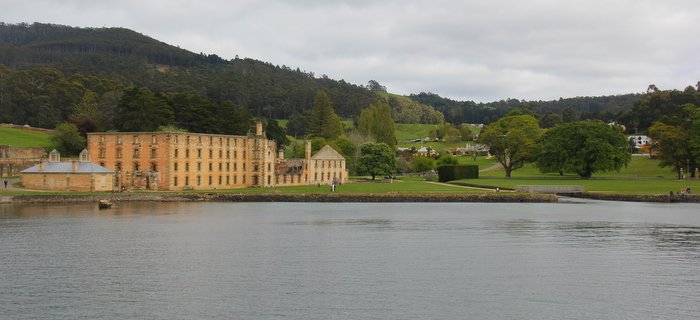Monday, October 3rd, 2011: Hobart, Australia
We awoke very early on this Monday morning, as we wanted to get a jump on rush hour traffic in the Hobart city center, in addition to trying to beat out the cruise buses to arrive at today’s destination, Port Arthur. Located about 100 kms away from Hobart by car, the single lane twisting, turning roads allowed us to enjoy the scenery as we made our way out to the community in which the military, free settlers, and a prison simultaneously occupied the area.
On our way to Port Arthur we past along a number of beautiful scenic lookouts, and with names like Pirate Bay, Fossil Bay, Tasman Arch, and Devil’s Kitchen, they were all worth a look and a quick stop along the way. As the towns got smaller and the scenery got more and more picturesque, we knew we were headed in the right direction and arrived to Port Arthur just after 8:30am and had a chance to tour the visitor’s center and have a bite to eat before our first tour at 9:30am.
In 1830, Port Arthur was identified as for penal station for timber gathering by convict labor, and the buildings and housing for these men was wholly inadequate. Three years later, it was designated a punishment station for repeat offenders and those considered “most difficult of the lot”. Here, hard work, discipline, religion, education, and reform were all attempted to develop a pattern of activity that would eventually bring about positive change in the men, women, and children brought to this place. Worked for some, while for others it simply found more structure and methods to rage against the machine — “A machine for grinding rogues into men.”
Nearly all of the buildings on the site were built by the convicts over the course of seven years, in which nearly every material was sourced, handmade, and built by the master craftsmen of the convict population. If a convict already knew a trade, it was put to work. If he didn’t have one, he was taught one. If he couldn’t read or write, and this was inhibiting him from having a trade, these skills were taught as well.
In the community of Port Arthur, amongst the 1600+ convicts, there were also another 1,000 to 1,500 people living in the community working for the military, or simply free settlers that had come to Port Arthur to start a new life in the colonies. It was an interesting dynamic that came into play here as convicts, those on good behavior and that had privledges, could go out and fish to supplement their ration of food, or could work in settler’s homes as a servant, yet the occasional leg irons and the issued prisoner clothing would quickly identify those with freedom from those simply attempting to make the most of many months to many years of captivity in the prison settlement.
In addition to the many trades of building, blacksmithing, shoemakers, tailors, cooks, and other trades, Port Arthur was also a ship building site, in which convict labor built some of the best sea-faring vessels in the entire region. Routinely identified as expert craftsmenship, many builders sought after Port Arthur builders to complete projects for their level of accuracy and design was superb. In addition to all of the buildings at the Port site, a convict architect designed and built the massive church located at the top of the hill. With 13 spires, it is considered one of the many masterpieces of architectural design in the community, along with the hand casted bells that were used in the steeples to call the community to mass.
Now, if we’re painting a picture of everything being just perfect harmony in this utopian society, it was still very far from it. A number of the prisoners simply did not like being imprisoned to begin with and quite often attitude and punishment came with it. Though there were no gallows at Port Arthur, usually sickness did in many prisoners, as the cramped quarters they stayed in until the larger penitenary buildings could be constructed allowed the quick spread of disease. 10+ hour days, 6 days a week in leg irons worked many prisoners down to the point of collapse and made them susceptible to all sorts of medical problems. And for those that still handled all of that and still had an evil streak? Corporal punishment on view in front of hundreds of other prisoners as the Cat of Nine Tails was applied in multiples of 25 lashes.
Corporal punishment was abolished shortly thereafter and a new prison, called the Separate Prison was built nearby. The goal here was sensory deprivation to play with the minds of the prisoners. Here, they were locked up 23 hours a day in solitary cells, forced to complete menial tasks of work that could be done in such a small space (bookbinding, weaving of cloth, etc.) and they were checked by the guards every 30 minutes. If you stopped working, during work hours, you were punished. Punishment was a minimum of 72 hours in the punishment cell, a completely blacked out cell, no windows, one door, and a minimum of 3 feet of sandstone to block out all noise. All you got in this cell was a single blanket and a hygiene bucket. Food rations were limited and with no understanding of time in the soundproof darkness, guards would routinely alter food delivery schedules just to throw prisoners off even more. It was a lot of twisted mind games, and they must have worked, as the next building to be added to the Port Athur station was an insane asylum.
As convict transportation to Port Arthur ended in 1853, most of the prisoners were shipped elsewhere or finished their sentences and went on to trades in the local area or in Hobart. The remaining dwindling population primarily supported the insane asylum until the entire settlement closed in 1877. At that point many of the buildings were closed or sold to the locals that turned them into hotels, etc. or just demolished some of the locations.
In the 1920s a movement began to start bringing back and restoring some of the remaining buildings on the site. While some were completely demolished, others had been damaged by fire. With what was remaining, the government stepped in much later and the site became its eventual historical landmark and museum site that it is today.
After touring the grounds and enjoying the tour, we had an opportunity to take the 11am harbor cruise around the bay surrounding Port Arthur and our guide onboard provided some additional information about the surrounding area including the development of Point Peur, an island prison just for boys ages 9-17 that were found guilty of repeat offense crimes as well as the Isle of the Dead where those that had died in Port Arthur were buried. Those with money and status were buried at the top of the hilly island with proper headstones, while those convicts with nothing receive the same status in death as they had in life — an unmarked grave on the lower slopes of the island.
After enjoying the grounds and seeing a number of the buildings, we closed out our day walking through the beautiful church remains and the Government House gardens. Once complete here, we began our trip back into Hobart to return the car and reboard our ship for the final leg of our 28 day cruise back to Sydney. Once the car was returned, we had about an hour before sailing so we made a few phone calls back home to family and then reboarded the ship. It was a great two days in Hobart and we welcome the opportunity to return to Tasmania as it would be a welcome destination for an extended stay in the future.



Leave a reply